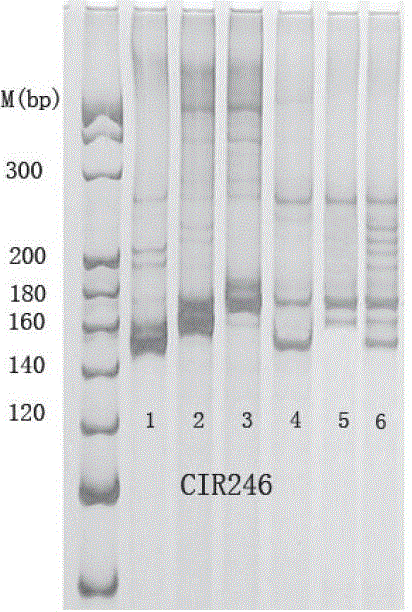Crop variety identity card management method
A management method and crop technology, applied in the field of molecular identification of crop varieties and variety quality management, can solve problems such as difficulty in accurately distinguishing, inability to achieve uniqueness requirements, and staying.
- Summary
- Abstract
- Description
- Claims
- Application Information
AI Technical Summary
Problems solved by technology
Method used
Image
Examples
example 1
[0071] Example 1: ID number of rice variety Wandao 153 (National Approved Rice 2008013):
[0072] OS11002008172424146634457711442517, which means: Wandao 153 is rice (OS), subspecies is indica (1), variety category is hybrid (1), variety approval area is China (00), variety approval time is 2008 ( 2008), the DNA fingerprint of the variety is 172424146634457711442517, which is a non-transgenic variety.
example 2
[0073] Example 2: The ID number of the transgenic insect-resistant cotton variety Ezamian No. 10 (National Approved Cotton 2005014):
[0074] GS1100200524324113233331433131132534T-Bt, which means: Ezamian No. 10 is cotton (GS), the cultivated species is upland cotton (1), the variety category is conventional species (1), the initial approval area of the variety is China (00), the variety The initial approval time was 2005 (2005), and the DNA fingerprint of the variety was 24324113233331433131132534, which is a transgenic Bt gene insect-resistant variety (T-Bt).
[0075] In addition to expressing the ID card number in a string of numbers (or letters), it can also be expressed in the form of a barcode, two-dimensional code or RIFD electronic chip. According to the relevant standards of China's article coding, the barcode is encoded with 128 codes. For example, the ID number of Wandao 153 is OS11342005123456789A87B54321123456, and the ID number of Ezamian No. 10 is GS1100200524...
Embodiment 1
[0077] Example 1, ID card construction of hybrid rice Wandao 153 (National Approved Rice 2008013):
[0078] 1. Rice genomic DNA:
[0079] Take a few rice seeds and germinate at 30°C. One week later, transfer a single seedling into a 2.0 mL centrifuge tube; add liquid nitrogen and use a glass rod to grind until powdery, add 700 μL 65°C preheated DNA extraction to the centrifuge tube solution, incubate at 65°C for 1 h, mix by inverting every 15 min; add an equal volume of chloroform:isoamyl alcohol (24:1) mixture, mix gently, and let stand at room temperature for 15 min; centrifuge at 10,000 g for 15 min, Pipette the supernatant into another 1.5 mL centrifuge tube, add an equal volume of isopropanol to mix, place at -20°C for 30 min, centrifuge at 10,000 g at 4°C for 10 min, discard the supernatant, and add 200 μL of 70% Wash the precipitate with ethanol; centrifuge at 10,000 g for 10 min, discard the ethanol, dry at room temperature, add 50 μL of sterilized water, fully dissol...
PUM
 Login to View More
Login to View More Abstract
Description
Claims
Application Information
 Login to View More
Login to View More - R&D
- Intellectual Property
- Life Sciences
- Materials
- Tech Scout
- Unparalleled Data Quality
- Higher Quality Content
- 60% Fewer Hallucinations
Browse by: Latest US Patents, China's latest patents, Technical Efficacy Thesaurus, Application Domain, Technology Topic, Popular Technical Reports.
© 2025 PatSnap. All rights reserved.Legal|Privacy policy|Modern Slavery Act Transparency Statement|Sitemap|About US| Contact US: help@patsnap.com



